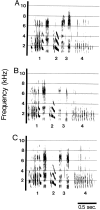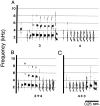Bengalese finches Lonchura Striata domestica depend upon auditory feedback for the maintenance of adult song
- PMID: 9236246
- PMCID: PMC6568371
- DOI: 10.1523/JNEUROSCI.17-16-06380.1997
Bengalese finches Lonchura Striata domestica depend upon auditory feedback for the maintenance of adult song
Abstract
Male birds of age-limited song-learning species develop their full song repertoires in the first year of life. For this type of song learner, once song is stabilized in adulthood, it is highly stereotyped and stable over time. Traditionally, it has been believed that age-limited song learners do not depend on auditory feedback for the maintenance of adult song. A recent report, however, showed that adult song in zebra finches, age-limited learners, does change after long-term deafness. We report here that another species of age-limited learner, Bengalese finches, depends critically on auditory feedback for adult song maintenance. We surgically deafened adult males and recorded song for 12 weeks after surgery. Results show that song degraded significantly within 1 week of surgery and continued to degrade over the next 11 weeks. This represents a more rapid degradation of song than has been seen previously in age-limited species. Song deficits after deafening included a marked decrease in syllable sequence stereotypy, skewed syllable distribution within song bouts, degradation of syllable phonology, and dropped, combined, and new or unrecognizable syllables. Decreased sequence stereotypy and combined syllables appeared within 1 week of deafening and did not worsen over time. Skewed syllable distributions and syllable phonology changes appeared after 1 week and did worsen. Occurrences of dropped and new syllables appeared within 1 week and increased over time. Comparison with other species indicates that much variability exists among species in the extent to which auditory feedback is necessary for song maintenance.
Figures








Similar articles
-
Adult Bengalese finches (Lonchura striata var. domestica) require real-time auditory feedback to produce normal song syntax.J Neurobiol. 1997 Oct;33(4):343-56. J Neurobiol. 1997. PMID: 9322153
-
Auditory feedback is necessary for the maintenance of stereotyped song in adult zebra finches.Behav Neural Biol. 1992 Jan;57(1):58-66. doi: 10.1016/0163-1047(92)90757-u. Behav Neural Biol. 1992. PMID: 1567334
-
Auditory experience and adult song plasticity.Ann N Y Acad Sci. 2004 Jun;1016:208-21. doi: 10.1196/annals.1298.017. Ann N Y Acad Sci. 2004. PMID: 15313777 Review.
-
Song complexity and auditory feedback in birds: a comparison between two strains of Bengalese finches with different degrees of song complexity.Zoolog Sci. 2012 Oct;29(10):645-51. doi: 10.2108/zsj.29.645. Zoolog Sci. 2012. PMID: 23030337
-
Sound sequences in birdsong: how much do birds really care?Philos Trans R Soc Lond B Biol Sci. 2020 Jan 6;375(1789):20190044. doi: 10.1098/rstb.2019.0044. Epub 2019 Nov 18. Philos Trans R Soc Lond B Biol Sci. 2020. PMID: 31735149 Free PMC article. Review.
Cited by
-
Variable sequencing is actively maintained in a well learned motor skill.J Neurosci. 2012 Oct 31;32(44):15414-25. doi: 10.1523/JNEUROSCI.1254-12.2012. J Neurosci. 2012. PMID: 23115179 Free PMC article.
-
Auditory feedback and song production do not regulate seasonal growth of song control circuits in adult white-crowned sparrows.J Neurosci. 2007 Jun 20;27(25):6810-4. doi: 10.1523/JNEUROSCI.1248-07.2007. J Neurosci. 2007. PMID: 17581968 Free PMC article.
-
Experimental test of the birdsong error-correction model.Proc Natl Acad Sci U S A. 2004 Nov 30;101(48):16935-40. doi: 10.1073/pnas.0407870101. Epub 2004 Nov 22. Proc Natl Acad Sci U S A. 2004. PMID: 15557558 Free PMC article.
-
A reafferent and feed-forward model of song syntax generation in the Bengalese finch.J Comput Neurosci. 2011 Nov;31(3):509-32. doi: 10.1007/s10827-011-0318-z. Epub 2011 Mar 15. J Comput Neurosci. 2011. PMID: 21404048 Free PMC article.
-
Expression analysis of the speech-related genes FoxP1 and FoxP2 and their relation to singing behavior in two songbird species.J Exp Biol. 2013 Oct 1;216(Pt 19):3682-92. doi: 10.1242/jeb.085886. J Exp Biol. 2013. PMID: 24006346 Free PMC article.
References
-
- Brenowitz EA, Kroodsma DE. The neuroethology of bird song. In: Kroodsma D, Miller E, editors. Ecology and evolution of acoustic communication in birds. Comstock; Ithaca, NY: 1996. pp. 285–304.
-
- Clayton NS. Song learning in Bengalese finches: a comparison with zebra finches. Ethology. 1987;76:247–255.
-
- Clayton NS. Song tutor choice in zebra finches and Bengalese finches: the relative importance of visual and vocal cues. Behaviour. 1988;104:281–299.
-
- Clayton NS. The effects of cross-fostering on selective song learning in estrildid finches. Behaviour. 1989;109:163–175.
Publication types
MeSH terms
Grants and funding
LinkOut - more resources
Full Text Sources
Medical
